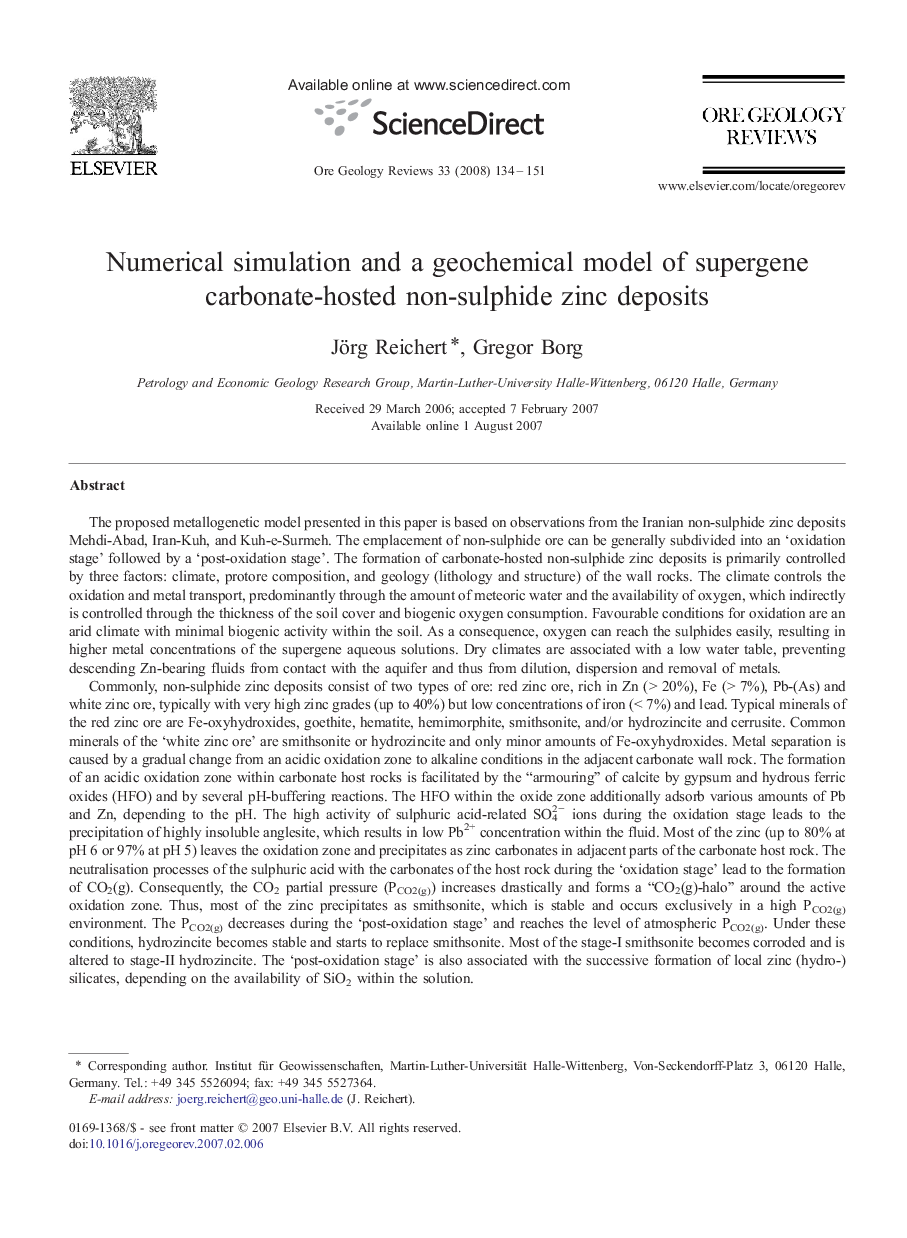| کد مقاله | کد نشریه | سال انتشار | مقاله انگلیسی | نسخه تمام متن |
|---|---|---|---|---|
| 4698086 | 1351926 | 2008 | 18 صفحه PDF | دانلود رایگان |

The proposed metallogenetic model presented in this paper is based on observations from the Iranian non-sulphide zinc deposits Mehdi-Abad, Iran-Kuh, and Kuh-e-Surmeh. The emplacement of non-sulphide ore can be generally subdivided into an ‘oxidation stage’ followed by a ‘post-oxidation stage’. The formation of carbonate-hosted non-sulphide zinc deposits is primarily controlled by three factors: climate, protore composition, and geology (lithology and structure) of the wall rocks. The climate controls the oxidation and metal transport, predominantly through the amount of meteoric water and the availability of oxygen, which indirectly is controlled through the thickness of the soil cover and biogenic oxygen consumption. Favourable conditions for oxidation are an arid climate with minimal biogenic activity within the soil. As a consequence, oxygen can reach the sulphides easily, resulting in higher metal concentrations of the supergene aqueous solutions. Dry climates are associated with a low water table, preventing descending Zn-bearing fluids from contact with the aquifer and thus from dilution, dispersion and removal of metals.Commonly, non-sulphide zinc deposits consist of two types of ore: red zinc ore, rich in Zn (> 20%), Fe (> 7%), Pb-(As) and white zinc ore, typically with very high zinc grades (up to 40%) but low concentrations of iron (< 7%) and lead. Typical minerals of the red zinc ore are Fe-oxyhydroxides, goethite, hematite, hemimorphite, smithsonite, and/or hydrozincite and cerrusite. Common minerals of the ‘white zinc ore’ are smithsonite or hydrozincite and only minor amounts of Fe-oxyhydroxides. Metal separation is caused by a gradual change from an acidic oxidation zone to alkaline conditions in the adjacent carbonate wall rock. The formation of an acidic oxidation zone within carbonate host rocks is facilitated by the “armouring” of calcite by gypsum and hydrous ferric oxides (HFO) and by several pH-buffering reactions. The HFO within the oxide zone additionally adsorb various amounts of Pb and Zn, depending to the pH. The high activity of sulphuric acid-related SO42− ions during the oxidation stage leads to the precipitation of highly insoluble anglesite, which results in low Pb2+ concentration within the fluid. Most of the zinc (up to 80% at pH 6 or 97% at pH 5) leaves the oxidation zone and precipitates as zinc carbonates in adjacent parts of the carbonate host rock. The neutralisation processes of the sulphuric acid with the carbonates of the host rock during the ‘oxidation stage’ lead to the formation of CO2(g). Consequently, the CO2 partial pressure (PCO2(g)) increases drastically and forms a “CO2(g)-halo” around the active oxidation zone. Thus, most of the zinc precipitates as smithsonite, which is stable and occurs exclusively in a high PCO2(g) environment. The PCO2(g) decreases during the ‘post-oxidation stage’ and reaches the level of atmospheric PCO2(g). Under these conditions, hydrozincite becomes stable and starts to replace smithsonite. Most of the stage-I smithsonite becomes corroded and is altered to stage-II hydrozincite. The ‘post-oxidation stage’ is also associated with the successive formation of local zinc (hydro-) silicates, depending on the availability of SiO2 within the solution.Generally, arid climates provide the best conditions for the preservation of non-sulphide deposits. The limited availability of meteoric water and deep to very deep water tables protect the non-sulphide ore from subsequent dissolution.
Journal: Ore Geology Reviews - Volume 33, Issue 2, April 2008, Pages 134–151